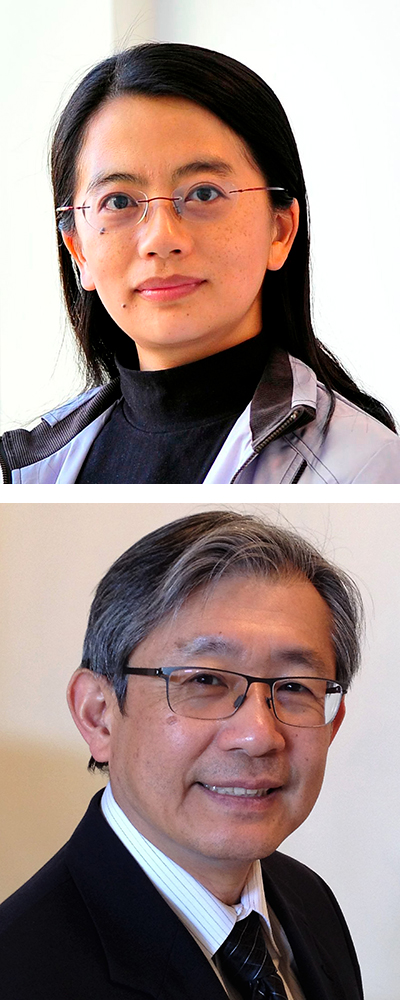
|
 |
Min Wu (top) and K. J. Ray Liu (bottom) |
|
ISR-affiliated Professor Min Wu (ECE) and Distinguished University Professor K. J. Ray Liu (ECE) have been named 2019 Fellows by the National Academy of Inventors (NAI), joining the ranks of some of the nation’s most prestigious and creative academic inventors.
According to the NAI, its Fellows Program “highlights academic inventors who have demonstrated a spirit of innovation in creating or facilitating outstanding inventions that have made a tangible impact on quality of life, economic development and the welfare of society. ...To date, NAI Fellows hold more than 41,500 issued U.S. patents, which have generated over 11,000 licensed technologies and companies, and created more than 36 million jobs. In addition, over $1.6 trillion in revenue has been generated based on NAI Fellow discoveries.”
The 2019 Fellows represent 136 research universities and governmental and non-profit research institutes worldwide and they collectively hold over 3,500 issued U.S. patents. Among the 2019 Fellows are six recipients of the U.S. National Medal of Technology & Innovation or U.S. National Medal of Science and four Nobel Laureates.
Professor Min Wu
“I am honored to be named a Fellow of the National Academy of Inventors, and feel very much blessed by having supportive inventors as mentors and collaborators along the way. Not only do I find the joy in discovery and innovations that can make a positive impact on the society, I also appreciate the opportunities to give back by sharing the invention process with students and helping them become future inventors,” said Wu, who joined the faculty of UMD’s Electrical & Computer Engineering Department (ECE) in 2001, and currently is an ECE Professor, a University Distinguished Scholar-Teacher, and Associate Dean for Graduate Program in the A. James Clark School of Engineering. Wu, who also is affiliated with the university’s Institute of Advanced Computer Studies and Institute for Systems Research, leads the Media And Security Team with main research interests in information security and forensics, and multimedia signal processing.
Among her many previous awards and recognitions are a National Science Foundation (NSF) CAREER Award in 2002, an MIT TR100 Young Innovator Award in 2004, an Office of Naval Research Young Investigator Award in 2005, a Computer World "40 Under 40" IT Innovator Award in 2007, a leader of University of Maryland Invention of the Year award winning teams in 2012 and 2015, and recognition as the IEEE Distinguished Lecturer in 2014.
Wu is a Fellow in both the AAAS and the IEEE “for contributions to signal processing, multimedia security and forensics.”
Distinguished University Professor K. J. Ray Liu
"I am honored to be named an NAI Fellow for the recognition of wireless AI technology that my team and I are developing,” said Liu, who is a Distinguished University Professor and the Christine Kim Eminent Professor of Information Technology in the Department of Electrical and Computer Engineering. “[This technology] has been deployed as Belkin's Linksys Aware for WiFi sensing for home security to over 150 countries worldwide. I am excited that we are making a real impact to the world with our technology.”
As part of multiple teams, Liu has three times received the University’s Invention of the Year Award: in 2013 for Time-Reversal Division Multiple Access for Wireless Broadband Communications, in 2011 for Active Sensing for Dynamic Spectrum Access, and in 2004 for Coding Techniques for Maximum Achievable Diversity in Space, Time and Frequency for Broadband Wireless Communications.
As an entrepreneur, in 2013 Liu founded Origin Wireless, based in Greenbelt, Maryland. This start-up company develops wireless AI analytic technologies for smart home systems. It invented the world’s first centimeter-accuracy indoor positioning/tracking system and the company’s patented TRM (Time-Reversal Machine) Technology has been applied to motion detection, home security, well-being monitoring, human breathing monitoring and fall-down detection without wearables or cameras. This technology can be used in many applications from Wi-Fi smart homes to smart tracing, with high performance, low cost and ease of use. The TRM technology won the Combined Exhibition of Advanced Technologies (CEATEC) Grand Prix Award after its worldwide debut. Since then, in partnership with industry companies such as Qualcomm and Marvell Technology Group, TRM technology is being deployed to millions of users worldwide in a variety of applications.
Among many pioneering works, Liu has also revolutionized wireless communication with the concept of cooperative communication by improving communication capacity, speed and performance; reducing battery consumption rates to extend network lifetimes, increase throughput and stability and expand transmission coverage area. Liu also is a Fellow in both the American Association for the Advancement of Science (AAAS) and the Institute of Electrical and Electronics Engineers (IEEE).
Previous UMD NAI Fellows
ISR now claims three faculty as NAI Fellows. Distinguished University Professor John Baras (ECE/ISR) and Distinguished University Professor Emeritus Ben Shneiderman (CS/ISR) were both inducted as NAI Fellows in 2015. In addition, C.D. (Dan) Mote, Jr., president emeritus of the National Academy of Engineering and a Regents’ Professor and former president of the University of Maryland, is a 2017 NAI Fellow; and Distinguished University Professor Rita Colwell is a 2016 Fellow.
The NAI was founded in 2010 to recognize and encourage inventors holding patents issued from the United States Patent and Trademark Office (USPTO); enhance the visibility of academic technology and innovation; encourage the disclosure of intellectual property; educate and mentor innovative students; and translate the inventions of its members to benefit society.
—ISR thanks Lee Tune, the University of Maryland's Associate Director of Communications, for this story.
Related Articles:
Manocha Named National Academy of Inventors Fellow
NAI Fellows' names read into the Congressional Record
Baras, Shneiderman named Fellows of the National Academy of Inventors
December 3, 2019
|

